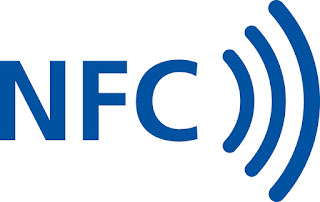TOPIC: - NFC
Q: WHAT IS NFC?
Ans: Near-field communication (NFC) is a set of
communication protocols that enable two electronic devices, one of which is
usually a portable device such as a smartphone, to establish communication by
bringing them within 4 cm (1.6inch) of each other. NFC devices are used in
contactless payment systems, similar to those used in credit cards and
electronic ticket smartcards and allow mobile payment to replace/supplement
these systems.
History
NFC is rooted in radio-frequency identification technology
(known as RFID) which allows compatible hardware to both supply power to and
communicate with an otherwise unpowered and passive electronic tag using radio
waves. This is used for identification, authentication and tracking.
(1) 1983 The first patent to be associated with the
abbreviation "RFID" was granted to Charles Walton.
(2) 1997 Early form patented and first used in Star Wars
character toys for Hasbro. The patent was originally held by Andrew White and
Marc Borrett at Innovision Research and Technology (Patent WO9723060). The
device allowed data communication between two units in close proximity.
(3) 2004 Nokia, Philips and Sony established the NFC Forum
(4) November 2015, Google’s Android Pay function
was launched, a direct rival to Apple Pay, and it started rolling out across
the US.
Operation Of NFC
(1) Near field communication is based on inductive-coupling
(2) NFC works using magnetic induction between two loop
antennas located within each others near field
(3) Operating frequency 13.56 MHz.data rate 106 kbit/s to
424 kbit/s
(4) NFC use an initiator and a target; the initiator actively
generates an RF field that can power a passive target
Applications of Near
Field Communication
1. Smart Cards
2. E-wallet (payment using smart phone)
3. Smart Ticketing
4. Medicine and Healthcare
5. Keyless Access
Applications of Near
Field Communication
1. Smart Cards
2. E-wallet (payment using smart phone)
3. Smart Ticketing
4. Medicine and Healthcare
5. Keyless Access
Future applications
of Near Field Communication
1. Smart Home:-
Using NFC and RFID technology we are able to customize and
program a particular application using our smart phone. By just activating an
NFC tag we can control our household equipments, app launching, access/lock
doors, set alarm functions or any particular task using smart phone.
2. Internet of Things and 5G:-
IoT and 5G opens window of opportunities for new
technologies to emerge. NFC enabled device will be required in IoT and 5G
enabled networks for easier implementation and efficiency.
3. Integrated Smartphone Applications:-
Smart RFID tags can be used to configure with smartphone
applications like receiving points for a loyalty program, membership access,
entry to a restricted area and many more customized applications.
Advantages of NFC:
1 .Convenience:-
Many consumers will "pay" for convenience because
convenience is very important in today's society. NFC is a perfect source of
convience because it merges a mobile device with wallet(s). NFC is also quite
intuitive; all it takes is a simple touch when using NFC for payments. Can you
imagine how much faster line ups would be at the grocery store, coffee shop,
etc
2. Versatility:-
NFC can be well adapted for all kinds of situations ranging
from bank cards to transit passes, movie passes, reward systems and even keys.
Ideally, NFC is suited for a broad range of industries and uses because this
innovation allows users to manipulate through the development of softwares.
3. Safety:-
(a) Now, you might think how could fusing your wallet into
your mobile device be safer. After all, just like a wallet, a cellphone could
be stolen. However when your wallet is stolen, the thief has access to all your
credit cards and information right away! With smartphones, passwords can be
used to further protect your information.
(b) NFC enabled credit cards are much more secure than a
credit card magnetic strip
(c) Requires PIN
(d) Retailers no longer have physical access to your credit
card information
Disadvantages
1. Only works in short ranges
2. Low data transfer rate
3. Can be costly for merchant companies to initially adopt
the technology
Conclusion
NFC tags will play inevitable role in future smart devices
for more integrated functions, smart transportation, aviation industry,
shipping, manufacturing industry for automation of particular tasks.
Integrating NFC technology with our modern data communication and transaction
process ensures convenience, time saving, energy efficiency and most
importantly improved security.







Comments
Post a Comment